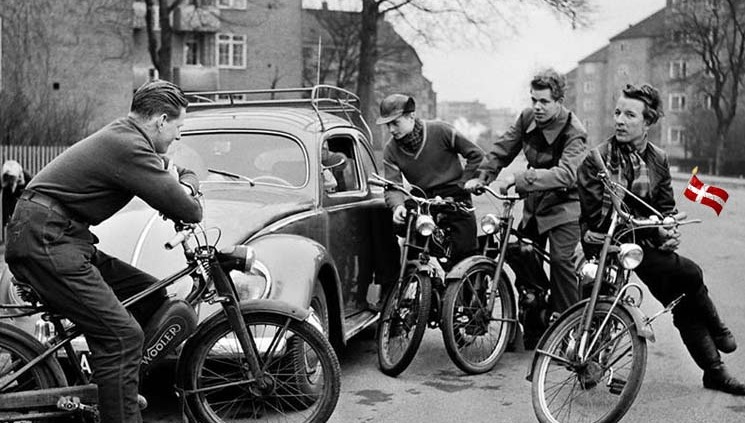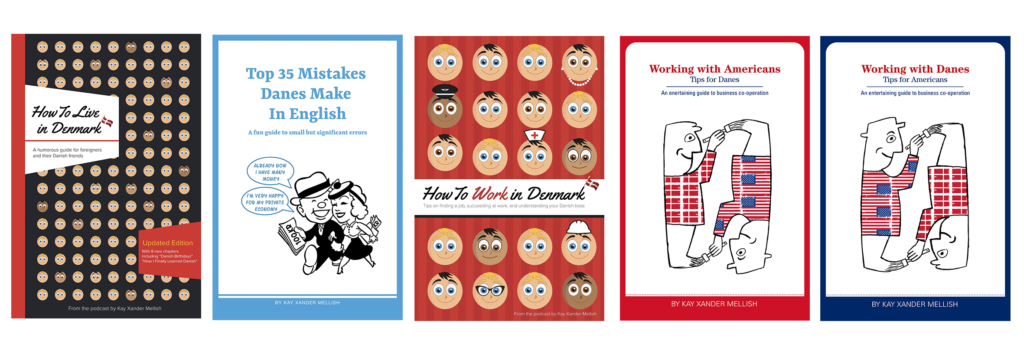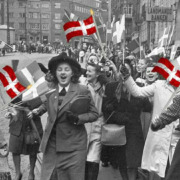Danes and Fear: What is there to be afraid of in Denmark?
I was walking towards my home in Copenhagen the other day, when I walked past a kindergarten. It had a big, open playground with lots things for the kids to climb on, but nobody was climbing. The kids were all gathered around a giant, open bonfire. Now, these kids were 3 to 5 years old, and the flames of the bonfire were probably twice as tall as they were. But there was no restraining fence or barrier to keep them away from it. Just a couple of adults and some pails of water.
Big open fires, which are called bål, are pretty common in Denmark, even around children. Sometimes the kids even roast little pieces of bread over the fire, or rather, a long piece of dough curled around a stick. Snobrød, it’s called. Kids grow up learning not to be afraid of fire. Maybe that’s a legacy of Denmark being such a cold country; fires were once very important to staying alive.
Even at Tivoli in the winter, you’ll see open containers of flaming hot coals – you know, the sort of things you usually see in depictions of Hell in Dante’s Inferno. But at Tivoli Danish parents are carefully showing their children how to warm their little fingers over the hot coals. No fear.
The little yellow card that removes fear
In general, Denmark is not a fearful country. You could argue, what is there to be afraid of in Denmark? It seems like a safe little corner of the world. Tax-funded social programs make it unlikely you’ll go hungry or homeless, as long as you have that little yellow social service card that shows you’re here legally. Your medical care and education is paid for by taxes – yours or somebody else’s. Even if you lose your job – and it’s very easy in Denmark for companies to get rid of workers they don’t want – there is the social safety net to catch you.
I’ve often thought that the social safety net is one of the reasons Danes have so little interest in religion. When there’s not much to worry about, there’s not much to pray for.
Denmark also has little of the open competition that can make life so stressful in competitive nations like China or India or the United States. Danish culture prizes consensus, not competition, and Danish children don’t get any formal grades in school until they’re in their teens. Any type of non-sports competition is discouraged. My 10-year-old daughter’s teacher caught the kids comparing their marks on a spelling test, and she told us parents about it disapprovingly. They shouldn’t be comparing themselves to each other, she said. They all have different abilities.
So the fear that kids live with in many parts of the world – of not being the best in class, not being able to get into a good secondary school or college, of being crossed off the list at a very young age – is largely absent in Denmark.
Scared at Nørreport station
Of course, Denmark is not immune from the world’s bigger fears – war, climate change, terrorism.
There was a terrorist attack a few months ago in Copenhagen: it was the first big one since the mid-1980s, when two large bombs went off downtown. In the 1980s attack, there were actually supposed to be three bombs. But as the third perpetrator tried to place his bomb on Vesterbrogade and walk away, an elderly lady stopped him and said, Excuse me, young man. You forgot your suitcase. He panicked, and he took his bomb and ran away.
But terrorism is still a real threat in Denmark, as it is all over the world. Probably the only time I’m afraid in Copenhagen is in Nørreport Station, a horrible dark little underground shoebox that is the central point for all the trains in town. It is a prime target for any kind of nutcase, and the Danish police seem to know that. Whenever things are tense in the world, Denmark’s usually invisible police force is highly visible at Nørreport.
Nørreport is also a center for pick-pocketing, which Denmark has mostly been outsourced to foreign criminals. Denmark’s own criminal gangs don’t do pick-pocketing. They specialize in narcotics, extortion, and strong-arm debt collection. Danish criminals gangs are known as rockers, and they belong to motorcycle clubs like the Hells Angels or the Bandidos. Modern rockers don’t look like their chic 1950s Marlon Brando black-leather inspirations; they tend to be large, hairy guys in hoodie jackets and colorful vests.
Tough guys get welfare payments
Actually, a lot of these tough guys also get Danish welfare payments – about half, according to the Danish tax service. They either claim disability, or say they’re simply unable to find a job. Of course, they’re supposed to go to job centers for retraining in order to get their benefits, but they never do. And if their caseworker tries to cut off those benefits….things can get ugly for that caseworker pretty fast.
It’s ironic that in a place where the social welfare system makes so many people feel secure, social welfare workers would have to worry about their safety.
In fact, if Danes have a real fear, it’s that something will happen to their safety net.
And you can see that beneath what is often expressed as a fear of immigration, of immigrants, of the outside world. If all these people come here from other places, can we still keep our welfare system? THAT’S a Danish fear.
[icon name=”facebook-square” class=”fa-3x”] [icon name=”twitter-square” class=”fa-3x”][icon name=”instagram” class=”fa-3x”]
Buy Kay’s books about Denmark on Amazon, Saxo, Google Books, Apple Books, Barnes & Noble Nook, or via our webshop.
Image mashup copyright Kay Xander Mellish [current_year]
Read also:
Just buy more insurance: Crime and Punishment in Denmark
Danish gangsters: Nighttime helicopters and the risks of a knit hat







The last paragraph suggested that immigrants could cause the collapse of the safety net. Very ill mannered to suggest that. Immigrants come to Denmark for the promise of a better living. They would not want to destroy it. They want to work and pay taxes and to be in the safety net together.
Hi Britta! That may indeed be the case, but this article isn’t about immigration – it’s about fear. The percentage of Danes who think immigration is the greatest threat to Denmark can easily be tracked by following Danske Folkeparti’s (The Danish People’s Party) support numbers. The last time I checked, Danske Folkeparti had the support of about 21% of the Danish electorate, which makes it Denmark’s third-largest, or perhaps second-largest, political party.
Hi Kay,
A great article. Both myself (a legal immigrant) and my Danish husband agree with you.
The fact is Denmark has a great social security structure but it is shaped like a pyramid, where the bottom majority paying in help to support the top minority on various types of welfare, be it old age, unemployment, sickness etc. – Or so it was.
Immigrants have become an easy target for blame of the feared collapse of this security, but it is not without it’s merits. As a ‘new’ Dane, I like many others – including many refugees, are mingling together learning Danish in the state funded institutions and so we learn a lot about our histories, why we are here, how we arrived and what our intentions are. Now there are many immigrants that I study with and most of them arrived illegally from countries like Syria and Eritrea. Most are escaping conflict in their countries of origin and most are seeking (or have already) had their families join them here in Denmark. So what happens? They arrive, are processed, get a house, social benefits including income, health care etc… They do have to have Danish lessons and go to the job centre, but as Danish is not their first language – and many don’t know it at all, this really is just a show to hold up and say ‘look they are integrating’! Many of them are, but I can tell you that many of them are not, and will not due to the polar differences in the culture they grew up in and the culture/religious differences here.
I have to add that as a legal immigrant I don’t get any of the above, save for healthcare and Danish lessons.
Now I’m not begrudging immigrants help because they obviously need it for integration, but as more and more arrive, how long will it be before the pyramid is inverted and the majority are made up of social welfare recipients and the minority are the tax payers? You don’t need to be Einstein to foresee the outcome. Something will have to give. The fear that many Danes have about their lifestyles and ‘safety net’ is common sense, even to this immigrant. But as was reported recently in a survey of immigrants over the last 10 years, only 1 in 4 are actually in paid employment and as more and more arrive.
This discussion is actually being had by many of the immigrants that I go to school with (many of them professionals back in their countries of origin) so it’s not – nor should it be, a discussion held without their input if they are to remain here in Denmark and Denmark should not be afraid to talk about it because that helps create the popularity of the far right parties.
Hello Kay, I just found your podcasts today and listened to many of them.
May I first comment on the podcasts, please excuse my seeming criticism.
Kay, you have lived in Denmark 15 years now and I am surprised at the pronunciation of Danish words, such as Odense or Nørrebrogade. I know it is ‘different’ the way you have to move your lips and tongue, but I would have thought you would do better by now.
Obviously, you can tell that I was once a Dane, likely by my directness, but I really mean no harm. Additionally, I am married to a Swede. She has lived in the USA for 51 years and I for nearly 66 years.
All that being said, I really enjoyed them immensely. I hadn’t realized how much Danish still remains within my being. I laughed out loud at many comments because I saw myself in them.
I was surprised.
If you like, and respond to me, I’d love to describe what it was like as a 9 year old to come to America knowing not a word of English and beginning school less than a month later.
Sincerely written,
Henning.
Hi Henning! Thanks for your comment. I’d love to hear your story of being a 9-year-old Dane “coming to America.” – Kay
Hello again, is there some easier way and a little more secure, that I could communicate?
I certainly enjoyed your talk about the Danish flag. It represents Danmrk, PERIOD!
Whether non nationals like it or not, it should remain THE symbol of Danmark.
If people don’t like it, they may leave and go back to the place they came from.